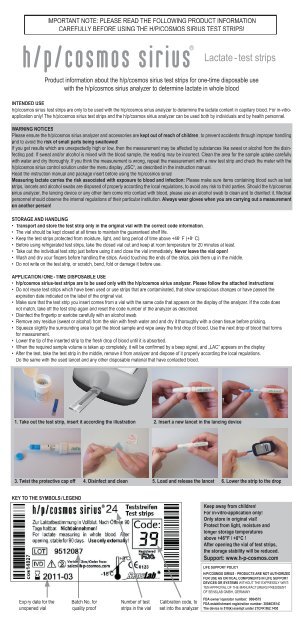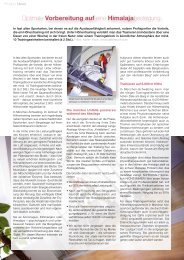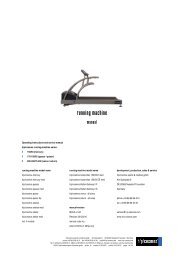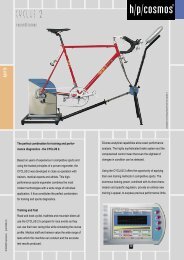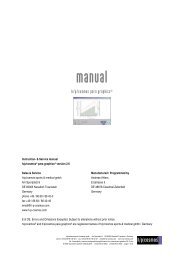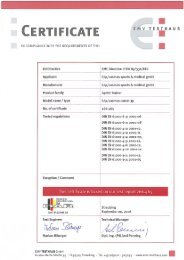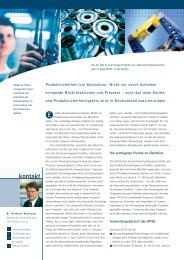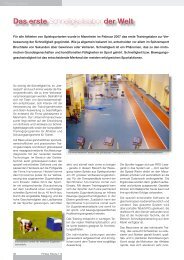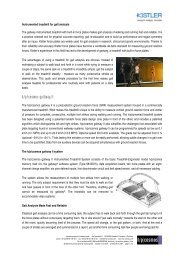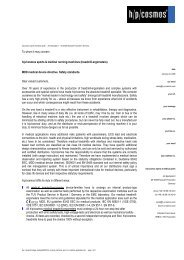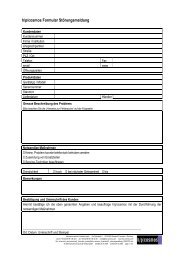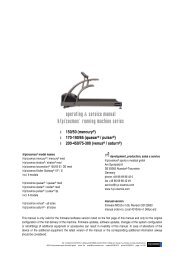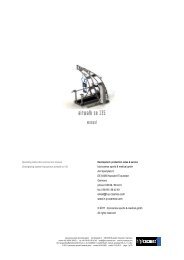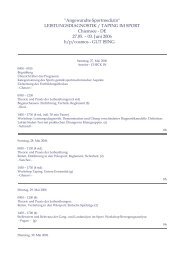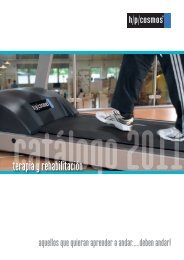manual - H-P-COSMOS Sports and Medical
manual - H-P-COSMOS Sports and Medical
manual - H-P-COSMOS Sports and Medical
You also want an ePaper? Increase the reach of your titles
YUMPU automatically turns print PDFs into web optimized ePapers that Google loves.
IMPORTANT NOTE: PLEASE READ THE FOLLOWING PRODUCT INFORMATION<br />
CAREFULLY BEFORE USING THE H/P/<strong>COSMOS</strong> SIRIUS TEST STRIPS!<br />
Lactate - test strips<br />
Product information about the h/p/cosmos sirius test strips for one-time disposable use<br />
with the h/p/cosmos sirius analyzer to determine lactate in whole blood<br />
INTENDED USE<br />
h/p/cosmos sirius test strips are only to be used with the h/p/cosmos sirius analyzer to determine the lactate content in capillary blood. For in-vitroapplication<br />
only! The h/p/cosmos sirius test strips <strong>and</strong> the h/p/cosmos sirius analyzer can be used both by individuals <strong>and</strong> by health personnel.<br />
WARNING NOTICES<br />
Please ensure the h/p/cosmos sirius analyzer <strong>and</strong> accessories are kept out of reach of children, to prevent accidents through improper h<strong>and</strong>ling<br />
<strong>and</strong> to avoid the risk of small parts being swallowed!<br />
If you get results which are unexpectedly high or low, then the measurement may be affected by substances like sweat or alcohol from the disin-<br />
fecting pad: If sweat <strong>and</strong>/or alcohol is mixed with the blood sample, the reading may be incorrect. Clean the area for the sample uptake carefully<br />
with water <strong>and</strong> dry thoroughly. If you think the measurement is wrong, repeat the measurement with a new test strip <strong>and</strong> check the meter with the<br />
h/p/cosmos sirius control solution under the menu display „dSC“, as described in the instruction <strong>manual</strong>.<br />
Read the instruction <strong>manual</strong> <strong>and</strong> package insert before using the h/p/cosmos sirius!<br />
Measuring lactate carries the risk associated with exposure to blood <strong>and</strong> infection: Please make sure items containing blood such as test<br />
strips, lancets <strong>and</strong> alcohol swabs are disposed of properly according the local regulations, to avoid any risk to third parties. Should the h/p/cosmos<br />
sirius analyzer, the lancing device or any other item come into contact with blood, please use an alcohol swab to clean <strong>and</strong> to disinfect it. <strong>Medical</strong><br />
personnel should observe the internal regulations of their particular institution. Always wear gloves when you are carrying out a measurement<br />
on another person!<br />
STORAGE AND HANDLING<br />
• Transport <strong>and</strong> store the test strip only in the original vial with the correct code information.<br />
• The vial should be kept closed at all times to maintain the guaranteed shelf life.<br />
• Keep the test strips protected from moisture, light, <strong>and</strong> long period of time above +46 o F (+8 o C).<br />
• Before using refrigerated test strips, take the closed vial out <strong>and</strong> keep at room temperature for 20 minutes at least.<br />
• Take out the individual test strip just before using it <strong>and</strong> close the vial immediately. Never leave the vial open!<br />
• Wash <strong>and</strong> dry your fi ngers before h<strong>and</strong>ling the strips. Avoid touching the ends of the strips, pick them up in the middle.<br />
• Do not write on the test strip, or scratch, bend, fold or damage it before use.<br />
APPLICATION / ONE - TIME DISPOSABLE USE<br />
• h/p/cosmos sirius-test strips are to be used only with the h/p/cosmos sirius analyzer. Please follow the attached instructions!<br />
• Do not reuse test strips which have been used or use strips that are contaminated, that show conspicious changes or have passed the<br />
expiration date indicated on the label of the original vial.<br />
• Make sure that the test strip you insert comes from a vial with the same code that appears on the display of the analyzer. If the code does<br />
not match, take off the test strip again <strong>and</strong> reset the code number of the analyzer as described.<br />
• Disinfect the fi ngertip or earlobe carefully with an alcohol swab.<br />
• Remove any residue (sweat or alcohol) from the skin with fresh water <strong>and</strong> <strong>and</strong> dry it thoroughly with a clean tissue before pricking.<br />
• Squeeze slightly the surrounding area to get the blood sample <strong>and</strong> wipe away the fi rst drop of blood. Use the next drop of blood that forms<br />
for measurement.<br />
• Lower the tip of the inserted strip to the fresh drop of blood until it is absorbed.<br />
• When the required sample volume is taken up completely, it will be confi rmed by a beep signal, <strong>and</strong> „LAC“ appears on the display.<br />
• After the test, take the test strip in the middle, remove it from analyzer <strong>and</strong> dispose of it properly according the local regulations.<br />
Do the same with the used lancet <strong>and</strong> any other disposable material that have contacted blood.<br />
1. Take out the test strip, insert it according the illustration 2. Insert a new lancet in the lancing device<br />
3. Twist the protective cap off 4. Disinfect <strong>and</strong> clean 5. Load <strong>and</strong> release the lancet 6. Lower the strip to the drop<br />
KEY TO THE SYMBOLS / LEGEND<br />
Expiry date for the Batch No. for Number of test Calibration code, to<br />
unopened vial quality proof strips in the vial set into the analyzer<br />
Keep away from children!<br />
For in-vitro-application only!<br />
Only store in original vial!<br />
Protect from light, moisture <strong>and</strong><br />
longer storage temperatures<br />
above +46°F / +8°C !<br />
After opening the vial of test strips,<br />
the storage stability will be reduced.<br />
Support: www.h-p-cosmos.com<br />
LIFE SUPPORT POLICY<br />
H/P/<strong>COSMOS</strong> SIRIUS - PRODUCTS ARE NOT AUTHORIZED<br />
FOR USE AS CRITICAL COMPONENTS IN LIFE SUPPORT<br />
DEVICES OR SYSTEMS WITHOUT THE EXPRESSLY WRIT-<br />
TEN APPROVAL OF THE MANUFACTURERS PRESIDENT<br />
OF SENSLAB GMBH, GERMANY.<br />
FDA owner / operator number: 9064575<br />
FDA establishment registration number: 3004635143<br />
The device is 510(k) exempt under 21CFR 862.1450
IMPORTANT NOTE: PLEASE READ THE FOLLOWING PRODUCT INFORMATION<br />
CAREFULLY BEFORE USING THE H/P/<strong>COSMOS</strong> SIRIUS TEST STRIPS!<br />
Product information about the h/p/cosmos sirius test strips for one-time disposable use<br />
with the h/p/cosmos sirius analyzer to determine lactate in whole blood<br />
SPECIAL RULES FOR LACTATE MEASUREMENT<br />
The h/p/cosmos sirius is easy to h<strong>and</strong>le: Nevertheless, sampling for lactate measurement has to follow some special rules to get meaningful<br />
results. One of the main reasons for wrong results is the contamination of the blood drop by sweat. The human skin is always covered with sweat,<br />
which contains a great deal of lactate. Due to the high density of sweat gl<strong>and</strong>s, especially in the fi ngertips, sweat is continuously secreted <strong>and</strong><br />
accumulated at the surface. If the fi nger was not washed by water, lactate accumulated from the sweat will be dissolved by the blood drop immediately<br />
after puncturing <strong>and</strong> the lactate reading will be much higher than it should be. Therefore, if possible, professional users prefer to draw the<br />
blood from the earlobe because there sweat secretion is much lower.<br />
In any case, to avoid taking an unclean sample ensure that the area (fi ngertip or earlobe) is cleaned carefully with water before sampling. Please<br />
note that alcohol swabs can disinfect your puncture area, but alcohol does not dissolve the lactate residue from the sweat. In addition, do not<br />
use saliva for cleaning, because it contains lactate also. To avoid other contaminations or dilution of the blood drop, dry the puncture area after<br />
cleaning / disinfection thoroughly. After puncture, the fi rst drop should be wiped away <strong>and</strong> the next drop that forms should be used immediately for<br />
the measurement. Within a few seconds, physical <strong>and</strong> chemical parameters of the blood drop are changing <strong>and</strong> sweat will be produced permanently<br />
which increases the lactate concentration. Hence, the delay time between drop generation <strong>and</strong> measurement should be very short.<br />
The lactate level of the blood depends on the individual metabolism of the body <strong>and</strong> of the state of the metabolism. Especially the glycogen<br />
storage of the body can affect the lactate level. E.g., the lactate concentration of the blood increases immediately after a meal. Depending on<br />
the individual metabolic activity, at least 90 minutes are required to approach a normal level between 1 - 2 mmol/l again. In contrast, after a hard<br />
physical exercise or diet, the glycogen storage is diminished <strong>and</strong> the glucose release from glycogen is limited for several (up to 24) hours resulting<br />
in lower lactate concentrations. For meaningful results it is recommended to carry out a step test (see below) under normal metabolic conditions.<br />
Diabetic, overweight, stressed or untrained persons or persons with heart diseases usually will fi nd increased lactate values. Here it is strictly<br />
recommended to collaborate closely with a doctor for supervision ensuring a careful <strong>and</strong> qualifi ed training control.<br />
HOW TO UNDERSTAND THE READINGS<br />
The lactate values that are obtained for certain effort levels must be charted as points (y-axis) above the corresponding values of running velocity or<br />
power (x-axis). The resulting curve which is obtained from the serial connection of these points has to be evaluated within the range between 2 mmol/l<br />
<strong>and</strong> 6 mmol/l. According to the Mader-model the anaerobic threshold is defi ned at 4 mmol/l. The more a prob<strong>and</strong> is trained, the more on the right the<br />
curve will pass the anaerobic threshold of 4 mmol/l.<br />
The steady state anaerobic threshold has an average of 4 mmol/l. But this value does not represent the individual characteristics of one‘s metabolism:<br />
The anaerobic threshold of an untrained person can be between 5 - 6 mmol/l lactate. In contrast, the anaerobic threshold of professionals usually ranges<br />
between 2.5 - 3 mmol/l lactate but passing at a much higher effort level. For that reason, the „individual anaerobic threshold (IAT)“ was introduced into<br />
sports medicine. Meanwhile there exist about 15 different methods <strong>and</strong> models to determine the IAT. Most of them are based on the determination of a<br />
well-defi ned increase of the lactate concentration via a tangent-method: For example, an angle of 45 was detected for runners using the running velocity<br />
as the effort level.<br />
To choose the proper testing method <strong>and</strong> an aligned evaluation system, it is advisable to proof carefully its performance <strong>and</strong> h<strong>and</strong>ling <strong>and</strong> use them<br />
long-term in an analogous manner. For ambitious amateurs <strong>and</strong> competitive athletes it is recommended to collaborate with experts of sports science <strong>and</strong><br />
coaching, to carry out the measuring at an optimum time <strong>and</strong> to use the data for effective improvement of endurance <strong>and</strong> fi tness. The application of an<br />
analyzer software (e.g. „h/p/cosmos sirius Assistant“ or „h/p/cosmos para analysis“) makes it much easier to illustrate <strong>and</strong> to interpret the data.<br />
TECHNICAL DATA<br />
Measuring method: The lactate of the sample is oxidized by the enzyme lactate oxidase. In the course of this redox<br />
reaction electrons are transferred via an additional electron mediator from the enzyme to a working<br />
electrode. This resulting measuring current corresponds with the lactate concentration.<br />
Measuring range: 0.5 - 25.0 mmol/l<br />
Sample volume: 0.5 µl<br />
Coeffi cient of Variation: 3.0 - 8.0% (depends on concentration; validated average)<br />
Reagent per test strip: Lactate oxidase, electron mediator, additives<br />
Interfering compounds: An increase of the readings up to 0.4 mmol/l is possible by uric acid at its highest physiological<br />
concentration <strong>and</strong> by acetaminophen/paracetamol at the highest therapeutic concentration applied.<br />
Haematocrit values above 0.5 l/l lead to higher results. Drugs taken may cause unexpected results.<br />
Contamination of the small blood sample with sweat or alcohol will result in inaccurate readings:<br />
Sweat (<strong>and</strong> saliva) contains a high lactate concentration. If alcohol or other solvents in the disinfecting<br />
pad mix with the blood drop, the red blood cells of the sample could be hemolyzed, so that com-<br />
pounds of the cells are released, causing inaccurate test results.<br />
Infl uence of temperature: The h/p/cosmos sirius is equipped with a temperature sensor, located below the test strip slot. The test<br />
results are adjusted automatically by an algorithm to enable reliable measurement in all kinds of temperatures.<br />
If the temperature before testing is too high or too low, the h/p/cosmos sirius will not function<br />
(no display of drop symbol): The analyzer displays a thermometer symbol then.<br />
If the temperature is below +41o F (+5o C), keep the device <strong>and</strong> the test strips near your body or in a<br />
warm <strong>and</strong> protected place. If the analyzer <strong>and</strong> the test strips have been exposed to extreme temperatures<br />
(lower than +41o F (5o C), or higher than +104o F (45o C)), a transition time of 20 min is needed.<br />
Ensure that the test strips <strong>and</strong> the meter are approximately at the same temperature.<br />
Health note: There are no known health risks from using h/p/cosmos sirius test strips according to the instructions if<br />
the test results are not used for therapeutic purposes (regard the life support policy on the front page).<br />
The test strip contains biologic material of animal origin. Risks of infection cannot be ruled out absolutely<br />
if the test strip is ingested.<br />
If you fell ill during testing, consult a doctor immediately, especially in case of improper use of the<br />
lancing device, swallowing of test strips, control solution, batteries or lancets.<br />
Persons prone to excessive bleeding or infection should consult a doctor before puncturing puncturing.<br />
Control solution (option): Contains lactate, buffer solution, <strong>and</strong> additives for viscosity adjustement <strong>and</strong> stabilisation.<br />
Do not swallow! Keep away from children! After fi rst opening of the bottle, the storage stability is<br />
three months at a storage temperature of +41 - 77o F (+5- 25o C) or until expiration if it‘s sooner.<br />
Open the bottle only immediately before application. Close it tightly afterwards. after Do not dilute!<br />
Additional control solutions are available as a regular content of the h/p/cosmos sirius „BigPack 72+“.<br />
Please read the instruction <strong>manual</strong> before using the control solution <strong>and</strong> the „dSC“-option!<br />
Distributed by: Manufacturer:<br />
h/p/cosmos sports & medical gmbh<br />
Am Sportplatz 8<br />
DE 83365 Nussdorf-Traunstein / Germany<br />
phone +49 (0) 8669 / 8642-0<br />
fax +49 (0) 8669 / 8642-49<br />
sales@h-p-cosmos.com<br />
www.h-p-cosmos.com<br />
Gesellschaft zur Entwicklung und Herstellung<br />
bioelektrochemischer Sensoren mbH<br />
Bautzner Straße 67<br />
D - 04347 Leipzig<br />
Tel.: 03 41 - 2 34 18 30<br />
Fax: 03 41 - 2 34 18 40<br />
www.senslab.de<br />
info@senslab.de<br />
Release: hpc-BPZ-TS-en_Rev 1.0_27.09.2010 0123


